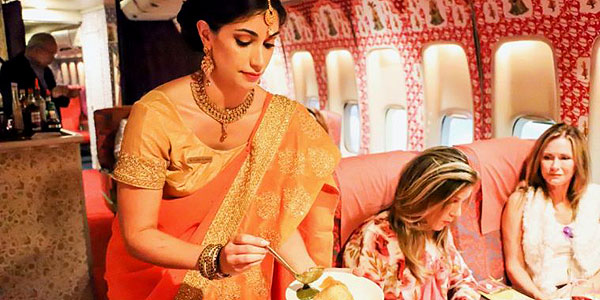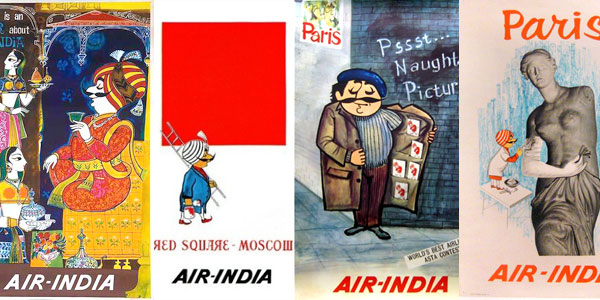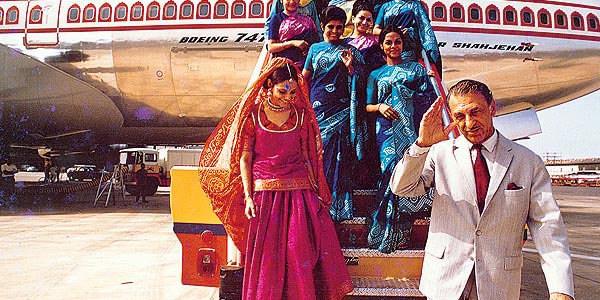|
OPINION Air India flies home at last but will encounter serious headwinds
JUMP TO Current column 
Air India in its heyday - tastes and colours of India, and immersive decor and superb service that airlines raced to copy. Singapore turned to Air India for advice when it decided to launch Singapore Airlines. WHILE I spent a major part of my early childhood making model aeroplanes from paper and balsa wood, even fashioning a six-foot contraption with bamboo reeds and plastic sheeting for my brother’s triumphal test flight around Mumbai, I never got to actually travel in a real plane till I was a little older. My first actual flight was from New Delhi’s breezy and informal Palam Airport in 1962 to join my parents in Mumbai where our family had just moved. The Vickers Viscount twin-prop looked enormous on the tarmac as my brother and I approached, its gleaming metal belly beckoning like some ungodly beast. The Viscount seated just over 40 in those days and was one of the most successful post-war aircraft. Unlike my bamboo invention that nosedived carrying my protesting brother into a rosebush after we had hurled him off higher ground, this wonder growled with power and urgency Send us your Feedback / Letter to the Editor I don’t recall much about that flight but I watched the flaps intently, later borrowing their movement for my paper planes that turned, rolled and did loops. From hand-chucked Spitfire gliders and rubber band-powered Bobnis (the propeller model of choice) to larger Chasers, it was then on to another real Indian workhorse, the F27 Fokker Friendship with its signature wings slung over the fuselage. This afforded excellent views on the flight from Mumbai to Kerala where we were to spend a long hot summer with my grandmother. By now my brother and I were seasoned frequent flyers and brought our Superman and Archie comics along. Seat reservation was a primitive but simple business back then and I simply whacked my brother on the head to secure a window view. I got all the comics as well using the same booking technique. These had to be smuggled aboard as my father, then an editor with the Times of India, wanted none of that POW, WHACK, KAPOW entering our lexicon, though he shared with great pride the daily Phantom comic strips that had just been syndicated to the paper. {The all new Air India will need to weather a turbulent Covid-19 wake and an estimated global airline industry loss of US$52bn... My brother and I travelled on our own, unassisted until the final deplaning when stewardesses would suddenly materialise and make a huge fuss over us as we were handed over to our parents. “Thank you darling,” my mother would beam at our supposed benefactor. Mysterious are the ways of airline service and so they remain. 
The airline's Maharajah mascot was a mischievous impish mascot that survived even heavy-handed government intervention when Air India got nationalised. In 1977 I was finally introduced to Air India. I found myself ensconced in a magnificent B747, poring over in-flight literature, route maps and rib-tickling images of the maharajah mascot posing in various capitals with his outsize moustache. I was headed to America via London on a student exchange. It was an exciting moment. I gallantly ordered red wine for the lady seated next to me, and a Coke for myself. Ah, the joys of flying! The sari-draped stewardess smiled sweetly and presented me a bill for almost two dollars, an extravagant and wholly unexpected mugging that relieved me of 10 percent of my meagre foreign exchange allowance of US$21. It was an instant lesson in the mirage of mile-high romance and the importance of thrift. Despite that initial shock, the Air India experience was remarkable. The plane flew close enough to the ground to make out natural features as we flew over Iran and the Middle East, almost grazing the coliseum as we banked into Rome. The jumbo landed just about everywhere – nothing was nonstop at the time – and I didn’t sleep a wink. I didn’t know it then but Air-India was at its peak. The service was gracious, the English impeccable, the interior design a lush immersion into the colours of India, and food was something you savoured, not chewed in shock. Unceremoniously nationalised by the government in 1953, Air India is back with the Tata group, the company that gave birth to it under the pioneering stewardship of JRD Tata, an avid pilot himself and former RAF airman Nevill Vintcent. Tata Air Mail took wing on 15 October 1932 with the young JRD piloting a Puss Moth from Karachi to Bombay (Mumbai) with a stop in Ahmedabad for fuel – leisurely hauled across to the aircraft on a bullock cart. The Moth was then flown by Nevill on to Madras (Chennai). It became Tata Air Lines in 1938, later transforming into Air India in 1946. Combined with Vistara (a joint venture with SIA) and AirAsia India, the Tata group will now have a roughly 25 percent share of the Indian market when the deal is consummated in December, placing it second after Indigo. 
JRD Tata led the airline from the front, serving as one of its first pilots in a Puss Moth and shepherding Air India on to the jet age with the B707 and later the widebody jumbo B747 (pictured here with JRD and his stewardesses). All will not be smooth sailing however. Amidst political opposition to the deal, administrative hangovers, bureaucratic misuse over the years, slipping service standards, and India’s well entrenched low-cost model where even high-maintenance Vistara with its premium service is forced to offer competitive fares, the new-look Air India will need to weather a turbulent Covid-19 wake and an estimated global airline industry loss of US$52bn for 2021 (down from the US$138 billion loss for 2020, according to the International Air Transport Association). An undertaking to retain all staff for one year could be another grating pebble in the maharajah’s shoes. Tata’s other high-profile loss-making acquisitions like Jaguar Land Rover and Tata Steel Europe (formerly Corus Steel) still face heavy weather, jet fuel prices are climbing, load factors are dipping, and long-time rival Jet Airways will likely take to the air once again in 2022 offering fresh competition. Neither Vistara nor AirAsia India have yet turned in a profit. Having acquired a 100 percent stake in Air India for US$2.4bn (along with US$3.1bn in debt, much of this picked up after a disastrous merger with Indian Airlines in 2007), the new entity will need to stake its turf with speed and vision. Two aces up its sleeve are the 4,400 domestic and 1,800 international landing slots that offer instant access to premium routes and flexibility. Landing slots are rarer than hen’s teeth these days and worth their weight in gold. The government will retain 75 percent of the airline’s remaining debt under Air India Assets Holding Ltd. AIAHL takes on ‘non-core assets’ like buildings and land and handle unpaid fuel bills and fees to airports. It is already responsible for four of the airline’s subsidiaries including an engineering offshoot and the Hotels Corporation of India (HCI). As with the Cathay Pacific merger with Cathay Dragon (earlier Dragonair) in 2020 with a separate low cost operation in the form of HK Express, Air India will have to look long and hard at its routes, manpower, skill sets and needs. Rationalisation will be necessary. While Vistara had lately added a few international routes (several suspended due to Covid), it remains largely a domestic player, subject to price-point pressure and in increasing conflict with AirAsia India and budget airline Air India Express. Here’s the rub. The cheapest one-way ticket Delhi to Chennai 23 November was Rs2,400 (US$32) on Vistara, Rs5,273 on AirAsia India (via Bengaluru), Rs2,343 on IndiGo, Rs2,621 on SpiceJet, and Rs2,658 on Air India. While airline fares are dynamic, this begs the question, which of these are the full service options? It is a muddle Air India must speedily sort. Internationally, it will be a long haul to wrest the top-dog mantle from SIA, Cathay, Emirates or Qatar. But it will be a show worth watching. Philanthropist, nation-builder and corporate mogul JRD Tata famously once said, “I never had any interest in making money. None of my decisions were influenced by whether it would bring me money or wealth.” It is something family scion Ratan Tata will need to seriously ponder as he attempts to follow JRD’s call to “always aim at perfection” – and turn a long-awaited profit. Send us your Feedback / Letter to the Editor Previous Columns2021 Why all roads lead homeBitcoin travelSpace Tourism for who?Rise of the killer botsVexxing anti-vaxxersCurse of curationMyanmar travel dilemmaExploding aircraft enginesBooks - travels in the mindPlanes, trains, automobiles
2020 Return of the flying SupermenWill airline bailouts flyThe Best of the DecadeWho will save Asia's hotels?Why we need more spaceWhy Covid is a big dealWho will give the first hug?Life of I, with a PumaThe world will be as oneWhy flu is nothing to sneeze atPlaying chicken in TaipeiSecret of powerless flight
2019 Broken bonds, dying brandsLately, the strangest feelingHow safe our skies?Is Hong Kong safe?Death of loyaltyNo rest on EverestBoeing fix leaves it in a fixCathay tries the limbo rockB737 MAX-8: accident by designI'm looking through youEveryone can auditionWhy is everyone screaming?
2018 The Sleep/Service equationThe Disappearing GMEco travel: less is moreBest of the restHow to win an awardPlane truth about punctualitySweet summer sweatWho's Top Dog?Don't unpack my bagPicture perfect holidaysTale of two women, or threeSomething in the air
2017 Hello, any humans here?An Aye for an AyeTravel, the fear factorHow to turn blue seas greenPolls, planes, queuesBlockade by blockheadsShanghai, back to the futureNo lap dance aloftFriendship is a rocketWhy I really need a dateIn the ICU with Legionnaires
2016 Give Bangalore its dueRoom at the VPN?How big can be beautifulWhy it's brand on the run Premeditation and physics Samsonite in a snit Bogged down by blogsRight brain has the right stuffWho's the fairest of them all?How have you been lately?Got a Black Magic Woman The rebranding of Asia
2015 Smoke gets in your eyesThe devil beaters of Hong KongThe lure of InstafameYes, still number oneStill tripping up onlineBetter late than neverCan you read bar codes?Domo arigato misuta robotoFast and furious - 2Terminal Man – the true storyHow bad ads kill good onesA matter of time
2014 Are you kidding me?Time to face the factsThe decline of reclineArt of hitchhikingShot out of the skyLies and statisticsBottoms up for goldShanghai surpriseNow, fake festivalsWhy ghetto is goodFrequently flummoxed flyersLaughing to the exits
2013 A matter of prideSpeak and it shall be understoodLet's go phishingAsia's best travel brandsBad scrambled eggsHow to pick a happy flightThe Wild Waist aloftClicks come a clatteringBrand on the runThe unfair fares affairSafe on cloud nine?Man-eaters of Mumbai
2012 The fine art of goodbyeStay fit or fake itMore than wordsWhy hotels and pigs can’t flyTo B or not to B737Are you being hacked?Snap-happy hounds bewareDelhi daze in springtimeLet's celebrate with KittyHide your prying eyesPilot project for beginnersGreen flights of fancy?
2011 The art of arriving lateWhen life drives you pottyAirports, awards, and alarmA fright for sore eyesDry skin wet eyesBack to the Tunnel of LoveWhy fearless flyers won't flee feesMore wind in the hairTravel tremors after JapanThe case of the intact bagsEnd of the OTA-man empire?A picture says a thousand words
2010 Only Engrish spoken hereVoices in the skyA tale of three airportsWhat's in a brandA big bite of a bad AppleNow haste to the hustingsJust 400 homicides and all's wellNo sex please, we're BritishSome minor details aloftHighway to the heavensYou look radiant darlingGood info a needle in a haystack
2009 Please watch that safety drillA classic cycle folderolUtterly eggcentric behaviourThe price is rightFlashing in public is a crime[Offset] my kingdom for a horseYour cash or I'll sneezeThe greening of the worldDo broccoli need passports?Could I see your profile?Great Scott! Empty seatsTravel in an age of terror
2008 There is no free lunchAnother Night in BangkokBeatings on the beachTravelling with Teenage KidsWhither Wi-Fi at 30,000ft?Are you locked in the toilet?Charge of the Flight BrigadeAcross the UniverseBaby it's cold outsideWhy I'm dying to travelA key questionGorillas in the mist
2007 Confounding customsWhen blackmail worksBy taxi through AsiaA really cheap dateMake a meal of itTales of two teethPutting curbs on carbsDial R for rip-offThe New Math aloftWhy boutique is bestAre you terminally mad?Heavy question, ladies
2006 The secret of good sleepJust bring Pluto backA fluid situation aloftWhy Friday's the bestNothing but the truthGone in 60 secondsJust use your imaginationFree flights for allIs your travel in vein?Pet peeves and solutionsViral travellers welcomeYes it's safe to step out
2005 A passage to IndiaIt is a "brand" new AsiaThe show must go onCriminally good holidaysThe accidental touristIt's a free rideSleep tips for the roadI'll follow the sunA good pillow fightA bridge too far?World's safest spotsThe need for speed
2004 Small is beautiful, sometimesBumming around AsiaSamsonite and DelilahJust one good bookSpace, the final frontierExtreme Travel for Real MenJust grin and bare itUnfazed by phraseHoney, I Shrunk My BrainMiss World to the RescueWhen things go bumpTo catch a croc, in Hongkong
2003
NOTE: Telephone and fax numbers, e-mails, website addresses, rates and other details may change or get dated. Please check with your dealer/agent/service-provider or directly with the parties concerned. SmartTravel Asia accepts no responsibility for any inadvertent inaccuracies in this article. Links to websites are provided for the viewer's convenience. SmartTravel Asia accepts no responsibility for content on linked websites or any viruses or malicious programs that may reside therein. Linked website content is neither vetted nor endorsed by SmartTravelAsia. Please read our Terms & Conditions. |
 A hundred years on, a doddering, if cheeky, indebted maharajah may have found the secret of renewed youth if the Tata acquisition of Air India gets off the ground.
A hundred years on, a doddering, if cheeky, indebted maharajah may have found the secret of renewed youth if the Tata acquisition of Air India gets off the ground.